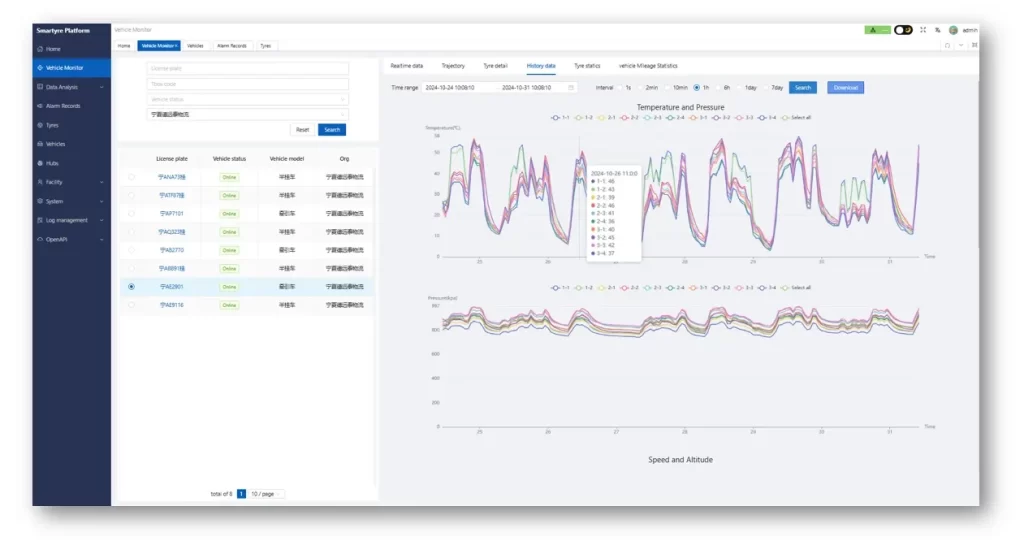In today’s world of fleet management, ensuring the safety and efficiency of vehicles is paramount. One of the key tools in achieving this is a Tire Pressure Monitoring System (TPMS). However, managing TPMS data across multiple vehicles can be challenging. This is where a TPMS Management Platform comes into play, providing fleet managers with a centralized, efficient solution. In this guide, we’ll explore what a TPMS is, why it’s essential, and how a management platform enhances vehicle performance and safety.

What is a Tire Pressure Monitoring System (TPMS)?
A Tire Pressure Monitoring System (TPMS) is a safety feature that alerts drivers when tire pressure falls below or exceeds the recommended level. Proper tire pressure is essential for safe driving, fuel efficiency, and tire longevity. There are two primary types of TPMS:
- Direct TPMS: Sensors inside each tire measure air pressure and transmit data to the vehicle’s dashboard.
- Indirect TPMS: This system uses data from the vehicle’s ABS system to detect pressure changes based on tire rotation.
Both systems help improve vehicle safety, but managing this data across multiple vehicles can be cumbersome without a centralized platform.
Why You Need a TPMS Management Platform
Managing tire pressure data across a fleet of vehicles can be a daunting task. A TPMS Management Platform centralizes this data, making it easier for fleet managers to monitor tire health in real time. With automated alerts, trend analysis, and maintenance recommendations, these platforms help ensure optimal vehicle performance and safety.
A TPMS management platform allows you to:
- Monitor tire pressure in real time: Receive alerts when tire pressure falls outside safe levels.
- Identify patterns: Track tire performance trends and spot recurring issues.
- Enhance safety: Prevent accidents caused by underinflated or overinflated tires.
Key Features of a TPMS Management Platform
An effective TPMS Management Platform offers numerous features that streamline tire management. Key features include:
1. Real-Time Tire Monitoring
One of the core features of a TPMS platform is real-time tire monitoring. Fleet managers can track tire pressure at any time and receive immediate alerts when a tire’s pressure is outside the recommended range. This proactive approach helps prevent tire failures before they occur.
2. Data Analytics and Reporting
Advanced data analytics allow fleet managers to analyze tire performance over time. The platform generates comprehensive reports that track trends such as tire pressure fluctuations, temperature changes, and wear patterns. These insights help optimize tire maintenance schedules, reducing costs and prolonging tire life.
3. Remote Access
Modern TPMS platforms offer remote access, enabling fleet managers to monitor tire health from anywhere. Whether in the office or on the road, operators can view real-time data, receive alerts, and make adjustments, ensuring efficient fleet management.
4. Automated Alerts and Notifications
Automated alerts are crucial for timely intervention. When tire pressure falls outside of the safe range, the platform sends notifications via email, text, or mobile app, enabling fleet managers to take immediate action.
5. Integration with Other Fleet Management Systems
A robust TPMS management platform integrates seamlessly with other fleet management tools such as GPS, maintenance scheduling, and fuel monitoring systems. This integration ensures efficient operations and simplifies fleet management.
Benefits of Using a TPMS Management Platform
Adopting a TPMS Management Platform brings significant benefits to fleet operators. Some of the key advantages include:
1. Enhanced Safety
By monitoring tire pressure in real time, the platform helps prevent accidents caused by underinflated or overinflated tires. Early alerts ensure quick action, reducing the likelihood of tire blowouts or other tire-related incidents.
2. Cost Savings
Maintaining optimal tire pressure leads to better fuel efficiency. Underinflated tires increase rolling resistance, which results in higher fuel consumption. Additionally, proper tire maintenance reduces wear and tear, decreasing the frequency of tire replacements and repairs.
3. Improved Fleet Performance
Proper tire pressure enhances vehicle performance, improving handling, braking, and overall driving stability. By using a TPMS management platform, fleet managers can ensure their vehicles are always operating at peak performance.
4. Extended Tire Lifespan
Regular monitoring and prompt maintenance extend the lifespan of tires. The platform helps fleet managers detect slow leaks or pressure deviations early, preventing premature tire wear and reducing replacement costs.
How to Choose the Right TPMS Management Platform
Selecting the right TPMS management platform requires careful consideration. Here are a few tips to ensure you choose the best solution for your fleet:
1. Compatibility
Ensure the platform is compatible with your fleet’s vehicles, whether they are light-duty trucks, heavy-duty vehicles, or passenger cars. Choose a platform that supports all types of vehicles in your fleet.
2. User-Friendly Interface
The platform should have an intuitive interface that allows fleet managers to quickly access and interpret tire data. A user-friendly system reduces training time and ensures efficient fleet management.
3. Scalability
As your fleet grows, your TPMS platform should be able to scale. Choose a platform that can handle an increasing number of vehicles and adapt to evolving fleet management needs.
4. Customer Support and Training
Look for a platform that offers reliable customer support and training resources. A strong support team can assist with troubleshooting, ensuring smooth platform implementation and use.

Conclusion
A Tire Pressure Monitoring System (TPMS) Management Platform is an invaluable tool for fleet managers. It not only helps monitor tire pressure in real time but also provides data analytics, automated alerts, and integration with other fleet management systems. By investing in a TPMS management platform, you can improve fleet safety, reduce costs, enhance performance, and extend tire lifespan.
With the right platform, fleet managers can ensure their vehicles are operating at optimal performance, making a TPMS Management Platform an essential tool for any modern fleet.

